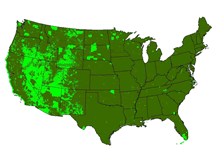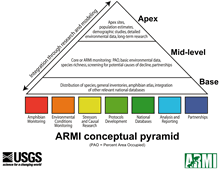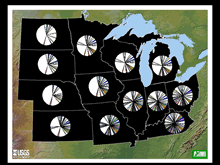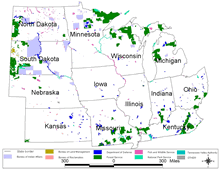ARMI at the Upper Midwest Environmental Sciences Center
Populations of amphibians have been declining around the world (Stokstad 2004). The US Geological Survey is working to understand the extent and causes of such declines via the Amphibian Research and Monitoring Initiative (ARMI). We are conducting research in support of this program in the Midwest Region of ARMI. Our offices and laboratories are at the Upper Midwest Environmental Sciences Center in La Crosse, Wisconsin. We produced the following pages to provide information on amphibians in our region and to help you understand our work. We hope you will find this information useful. If you have information that could help us assess the statuses of populations of amphibians, please contact us.
|
- This integrated approach enables ARMI scientists to characterize
and monitor the statuses of populations, formulate hypotheses
about causes of any declines observed, test these hypotheses through
specific studies, and draw conclusions about causes of declines.
- Surveying and monitoring are expected to provide sound scientific
data that will enable ARMI scientists to characterize and monitor
the statuses of populations, formulate hypotheses about causes
of any declines observed, test these hypotheses through specific
studies, and draw conclusions about causes of declines and the
persistence of populations.
- Partnerships are an integral component of ARMI. Researchers
from a variety of organizations (e.g., the North American Amphibian
Monitoring Program, the US Forest Service, State Heritage Programs,
State Departments of Natural Resources, and nongovernmental organizations)
will contribute data, especially to the lower levels of the pyramid,
largely from surveys and monitoring conducted on lands that are
not federally owned.
- Results from ARMI add considerably to our knowledge of populations
of amphibians and the environmental factors that affect them.
- Such knowledge enables people who establish public policy and
manage natural resources to make more informed decisions.
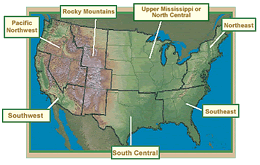 |
| |
Midwest Region of ARMI
-
The conterminous United States are divided into seven
regions of study under ARMI
(Figure
3).
-
Scientists from USGS Science Centers coordinate
and conduct work under ARMI in each region.
- Staff at the Upper Midwest
Environmental Sciences Center (UMESC) in La Crosse, Wisconsin,
are responsible for executing ARMI in the 13 states of the Midwest Region (UMR of ARMI, also known as the North Central
Region).
-
Approximately 89 species and subspecies of
amphibians live in the UMR of ARMI ( Table
1; Figure 4) (Conant and
Collins 1998; Lannoo 1998; Fischer et al. 1999; Potts et al.
1999; Kansas Department of Wildlife and Parks 2003; Kentucky
State Nature Preserve Commission 2003; NatureServe 2004;
University of Nebraska 2004).
- Most populations of these species do not live on federal lands; fewer still live on
the subset of federal lands managed by the DOI. (Figure 5 )
Overarching Goal
of ARMI in the Upper Mississippi River
- Continue to develop the infrastructure, studies, and partnerships
necessary to address ARMI’s core goals and objectives.
Approach
- Address the goals of ARMI by approaches described in the ARMI
pyramid.
- Address the core elements of ARMI by surveying and monitoring
populations of various species.
- Work with other organizations to obtain relevant data to allow
a broader assessment of populations across the UMR of ARMI.
- Complement data from surveys and monitoring by assessing potential
causes of previous and future declines.
- Conduct our work in locations and by methods that maximize our
ability to gather high-quality data and provide direct benefits
to resource managers and decision makers.
Literature
Cited
Conant, R., and J. T. Collins. 1998. Reptiles
and amphibians: eastern and central North America. Third edition,
expanded. Houghton Mifflin Co., New York. 616 pp.
Fischer, T. D., D. C. Backlund, K. F. Higgins, and D. E. Naugle.
1999. A field guide to South Dakota Amphibians. Bulletin 733. South
Dakota State University. 52 pp.
Kansas Department of Wildlife and Parks. 2003. Species at risk.
Available online at http://www.gpnc.org/threaten.htm.
Kentucky State Nature Preserves Commission. 2003. Endangered, threatened,
and special concern list search. http://nrepcapps.ky.gov/ksnpc/etsquery.asp.
Lannoo, M. J. 1998. Status and conservation of midwestern amphibians.
University of Iowa Press, Iowa City. 507 pp.
NatureServe. 2004. NatureServe Explorer, an online encyclopedia
of life. http://www.natureserve.org/explorer/.
Potts, G., J. T. Collins, and K. Shaw. 1999. A checklist of the
vertebrate animals of Kansas. 2nd edition. University of Kansas
Museum of Natural History, Lawrence. 50 pp.
University of Nebraska. 2004. Reptiles and amphibians of Nebraska.
http://snrs.unl.edu/herpneb/.
|


